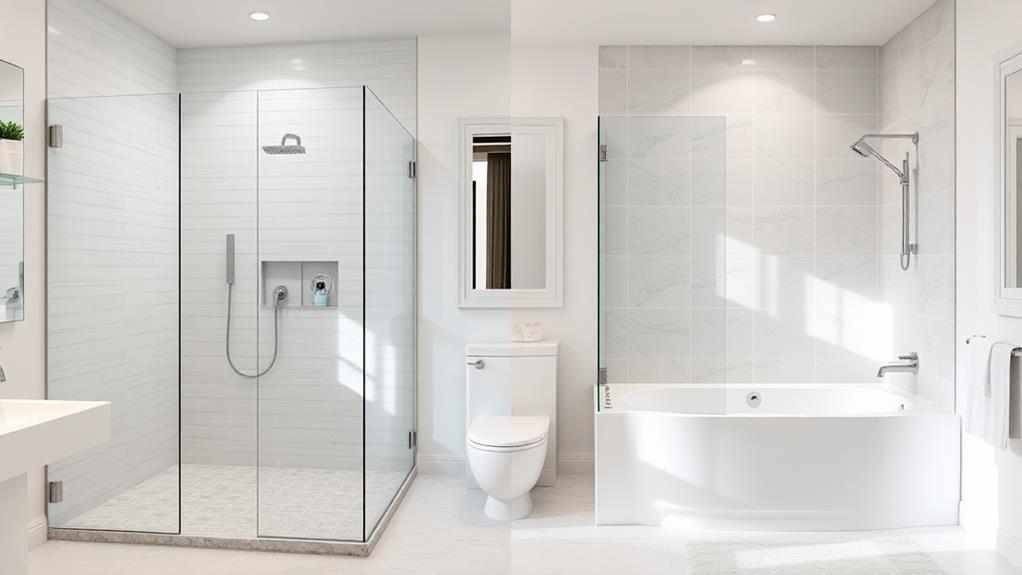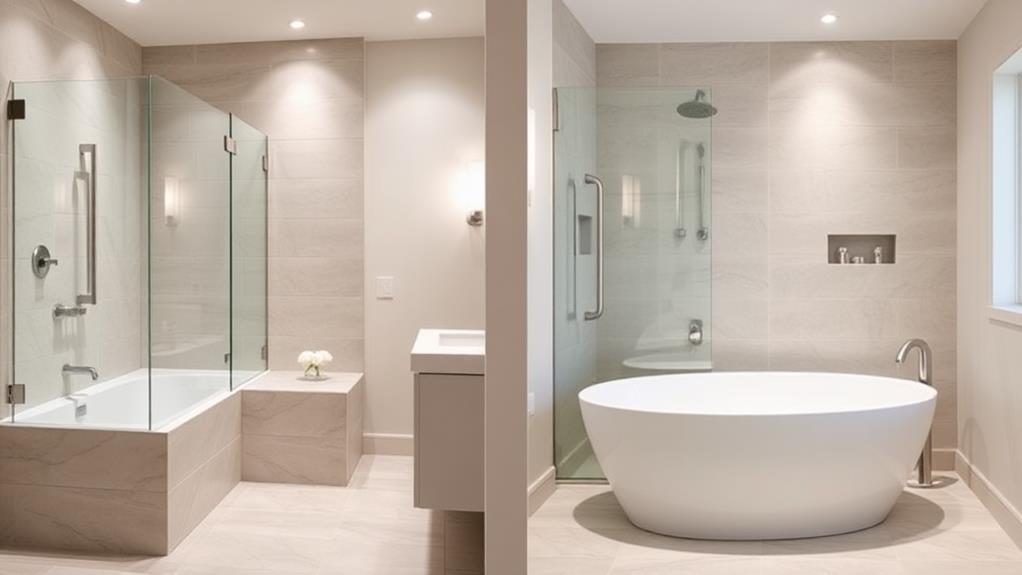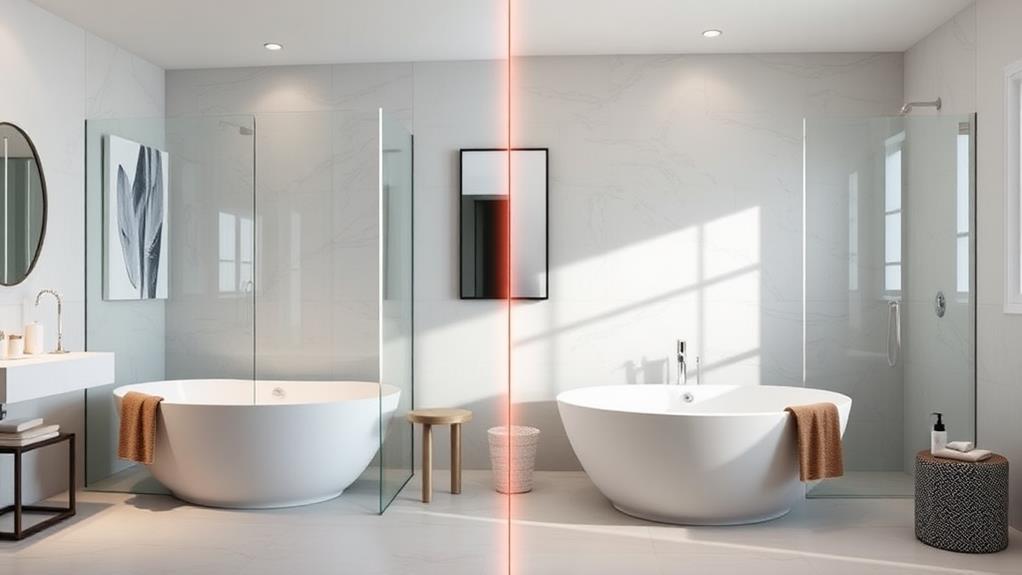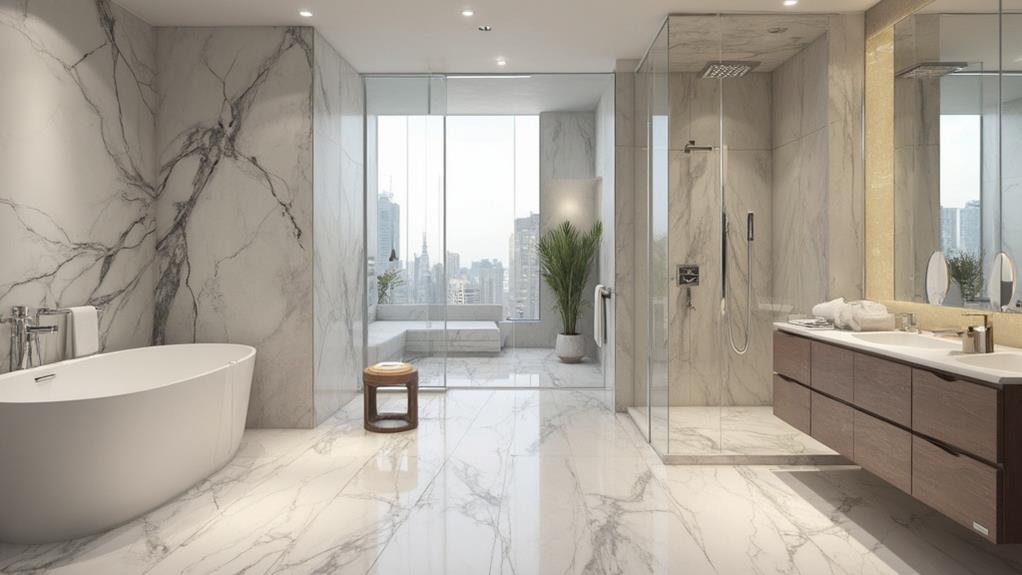When choosing between a tub-shower combo and separate fixtures, consider your available space, functionality needs, aesthetic preferences, budget, and potential resale value. Tub-shower combos are space-efficient and versatile, ideal for compact bathrooms or homes with young children. Separate fixtures offer more design flexibility and accessibility but require more space and investment. Your decision should align with your lifestyle, bathroom size, and long-term goals. Factor in maintenance, cleaning efforts, and the appeal to future buyers. Weigh the pros and cons carefully, as your choice will impact your daily routine and home value for years to come.
Space Considerations

Two key factors dominate space considerations when choosing between a tub-shower combo and separate fixtures: available square footage and layout optimization. If you're working with a small bathroom, a tub-shower combo might be your best bet. It maximizes functionality while minimizing the footprint, typically occupying about 13 square feet. This option works well in compact spaces, allowing you to have both bathing options without sacrificing precious floor area.
On the other hand, if you've got a larger bathroom, separate fixtures offer more flexibility. A standalone shower can be as small as 9 square feet, while a freestanding tub might require 15 square feet or more. This setup allows for a more spacious shower experience and a luxurious soaking tub, but it does demand more overall space.
Consider your bathroom's layout when deciding. A combo unit can fit neatly into a corner or along a wall, while separate fixtures give you the freedom to create distinct zones within the room. You'll need to account for door swings, traffic flow, and other fixtures like vanities and toilets when planning your layout. Remember, efficient use of space isn't just about fitting everything in—it's about creating a functional, comfortable environment that meets your needs.
Functionality and Practicality
Considering functionality and practicality, your choice between a tub-shower combo and separate fixtures should align with your daily routines and long-term needs. A tub-shower combo offers versatility, allowing you to take quick showers or enjoy a relaxing bath. It's ideal for families with young children or those who value the option of both bathing methods. However, stepping over the tub's edge can be challenging for some, especially older adults or those with mobility issues.
Separate fixtures provide specialized functionality. A standalone shower offers easy access and is perfect for those who prefer quick, efficient bathing. It's also safer for individuals with limited mobility. A separate tub, whether it's a standard or luxurious soaking tub, creates a spa-like atmosphere for those who enjoy long, relaxing baths. However, maintaining two separate fixtures may require more cleaning time and effort.
Consider your household's needs: Do you have young children or pets that need bathing? Do you or family members have mobility concerns? Will your needs change in the future? Your answers to these questions will help guide your decision towards the most practical and functional option for your bathroom.
Aesthetics and Design Options

When it comes to aesthetics and design options, both tub-shower combos and separate fixtures offer a wide range of possibilities to suit your personal style. Tub-shower combos often feature sleek, modern designs with clean lines and minimalist hardware. You'll find options in various materials, including acrylic, fiberglass, and even high-end stone composites. These combos can be customized with decorative tile surrounds, glass doors, or curtains to match your bathroom's decor.
Separate fixtures allow for more creativity in your bathroom layout. You can choose a freestanding tub as a focal point, selecting from classic clawfoot designs, modern soaking tubs, or luxurious whirlpool options. Standalone showers offer even more design flexibility, with options like frameless glass enclosures, walk-in designs, or multi-head systems for a spa-like experience.
Color choices are virtually limitless for both options, ranging from neutral whites and grays to bold, statement-making hues. You can also mix and match finishes on hardware and fixtures to create a unique look. Whether you prefer a cohesive, streamlined appearance or want to make a bold design statement, you'll find options to suit your taste in both tub-shower combos and separate fixtures.
Cost Implications
Cost plays a crucial role in deciding between a tub-shower combo and separate fixtures. Tub-shower combos are generally less expensive, making them a popular choice for budget-conscious homeowners. You'll save on both material and installation costs, as you're essentially getting two functions in one unit. Additionally, you'll need fewer plumbing connections, which can further reduce expenses.
Separate fixtures, while more costly, offer flexibility in terms of customization. You can choose high-end materials for each piece, potentially increasing your overall investment. Installation costs will be higher, as you'll need separate plumbing for both the tub and shower. However, if you're only installing a standalone shower, you might save money compared to a combo unit.
Consider long-term costs as well. Tub-shower combos may require more frequent cleaning and maintenance due to their dual-purpose nature. Separate fixtures might be easier to keep clean and could last longer. If you're planning to sell your home, separate fixtures might add more value, potentially offsetting the initial higher cost. Ultimately, your budget and long-term goals will guide your decision between these options.
Resale Value Impact

The impact on resale value can be a deciding factor when choosing between a tub-shower combo and separate fixtures. Generally, homes with at least one bathtub tend to have higher resale values, as they appeal to a broader range of potential buyers, including families with young children.
If you're considering separate fixtures, keep in mind that a standalone shower can be a selling point for some buyers, especially in master bathrooms. However, it's crucial to maintain at least one bathtub in the house to maximize your property's appeal. Luxury home buyers often prefer spacious, separate showers and tubs in the master suite.
For smaller homes or apartments, a tub-shower combo might be the most practical choice, as it offers versatility without sacrificing space. This option can help maintain your property's resale value while catering to various preferences.
Ultimately, your decision should align with your neighborhood's standards and target market. Research local real estate trends and consult with a realtor to determine which option will best preserve or enhance your home's value in your specific area.
Conclusion
You've weighed the pros and cons of tub-shower combos and separate fixtures. While some might argue that combos are always more practical, don't let that limit your vision. Consider your space, budget, and lifestyle needs carefully. Whether you choose the versatility of a combo or the luxury of separate units, you're making an investment in your home's comfort and value. Trust your instincts, and you'll create a bathroom that perfectly suits your needs.

